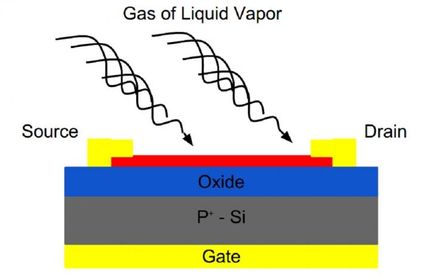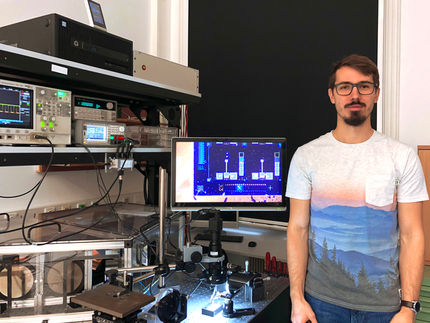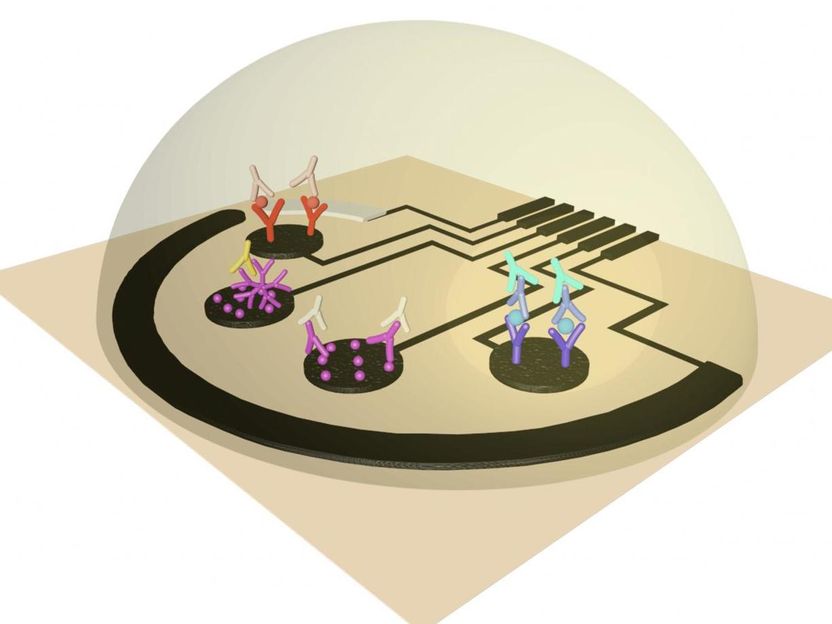New chemical sensor makes finding landmines and buried IEDs easier
A chemical sensing system developed by engineers at the University of Connecticut is believed to be the first of its kind capable of detecting vapors from buried landmines and other explosive devices with the naked eye rather than advanced scientific instrumentation.
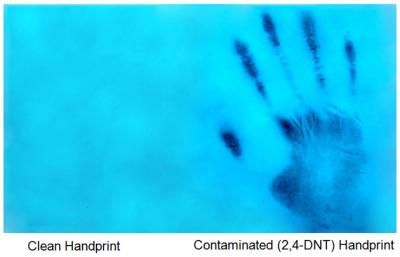
University of Connecticut scientists have developed a novel buried explosive detection system using a nanofiberous film and ultraviolet light. This image shows detection of particulate explosives on a contaminated hand using the novel electrospun pyrene film.
Image courtesy of Ying Wang/UConn and Advanced Functional Materials, Wiley-VCH Verlag GmbH & Co. KGaA.
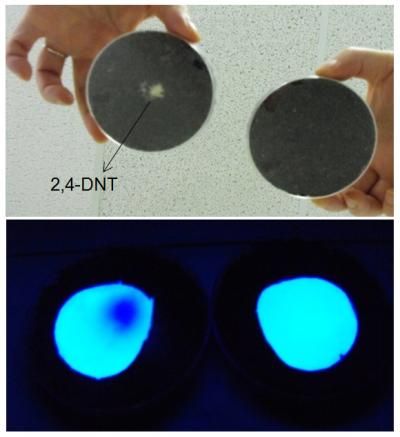
Image, top, shows a Petri dish (left) with buried trace levels of 2,4-DNT explosive in soil and a Petri dish (right) without DNT. Image, bottom, shows each Petri dish after application of the chemical sensing film and following 30 minutes exposure under ultraviolet light. The location of the buried DNT appears in the Petri dish (left) as a dark blot on the film.
Image courtesy of Ying Wang/UConn and Advanced Functional Materials, Wiley-VCH Verlag GmbH & Co. KGaA.
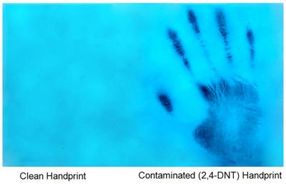
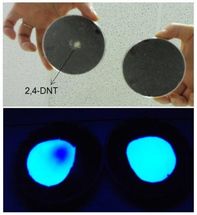
The research was first reported in the May 11, 2012 online edition of Advanced Functional Materials.
The key to the system is a fluorescent nanofiberous film that can detect ultra-trace levels of explosive vapors and buried explosives when applied to an area where explosives are suspected. A chemical reaction marking the location of the explosive device occurs when the film is exposed to handheld ultraviolet light.
The system can detect nitroaromatics such as those found in TNT and 2,4-DNT (the military's primary explosive and the principle components in landmines) as well as the elements used in harder to detect plastic explosives such as HMX, RDX, Tetryl, and PETN. The ultra-sensitive system can detect elements at levels as low as 10 parts per billion (TNT), 74 parts per trillion (Tetryl), 5 ppt (RDX), 7 ppt (PETN) and 0.1 ppt (HMX) released from one billionth of a gram of explosive residue.
If there is no explosive vapor present, the recyclable film retains a bright fluorescent cyan blue color when exposed to ultraviolet light. If explosive molecules are present, the fluorescence is quenched and a dark circle identifying the threat forms on the film within minutes.
"Our initial results have been very promising," says UConn Dr. Ying Wang, who developed the system as a chemical engineering doctoral student working under the supervision of UConn Associate Engineering Professor Yu Lei. "We are now in the process of arranging a large-scale field test in Sweden."
Rather than using sophisticated chemical modifications or costly synthetic polymers in preparing the sensing material, UConn scientists prepared their ultra-thin film by simply electrospinning pyrene with polystyrene in the presence of an organic salt (tetrabutylammonium hexafluorophosphate or TBAH). This resulted in a highly porous nanofiberous membrane that absorbs explosive vapors at ultra-trace levels quickly and reliably. The film also has excellent sensitivity against common interferences such as ammonium nitrate and inorganic nitrates. Initial vapor detection took place within seconds with more than 90 percent fluorescent quenching efficiency within six minutes.
According to the United Nations, there are an estimated 110 million active landmines hidden underground in 64 countries around the world. It is estimated that as many as 25,000 people are maimed or killed by landmines each year across the globe. The mines not only threaten people's lives, they can paralyze communities by limiting the use of land for farming or roads for trade.
Clearing mines is a slow and deliberative process often involving specially-trained dogs and metal detectors, but each method has its shortcomings. Dogs, considered the gold standard in detection, eventually tire and can experience difficulty differentiating in dense minefields. Metal detectors are prone to false positive readings that can be triggered by buried pieces of metal unrelated to a mine or unexploded ordinance.
While explosive material can be concealed within landmines and IEDs, the seal is often not airtight and small amounts of vapors escape allowing for detection.
The film developed by Wang and Lei is very light weight, similar to paper, and can be rolled out over a suspect area like a sheet. The electrospinning process makes it both easy and affordable to produce.
"We would be very interested in following up on any kind of research that looks at chemical detection systems," says Erik Tollefsen, advisor for stockpile destruction, EOD and technology for the Geneva International Centre for Humanitarian Demining (GICHD). "This is something we might use as a quality control tool for animal detection. There are some cost benefits here."
"The general observation is that chemical detection systems work on a nano-level and our animal-based systems are on the pico-level, which is 1,000 times more sensitive," Tollefsen says. "But obviously with animals, you can't switch them on and off like a machine and they are sometimes difficult to work with."
Wang and Lei have also developed a novel chemical test for detecting TNT in water and other liquids. The application could be used to detect potential terrorist threats in airports as well as groundwater contamination in areas where explosives were used in construction.
The ultra-sensitive, real-time sensor can detect TNT concentrations ranging from about 33 parts per trillion (the equivalent of one drop in 20 Olympic-sized swimming pools) to 225 parts per million.
"Our new sensor based on a recently developed fluorescent polymer for explosives in aqueous samples has two sensing mechanisms in one sensing material, which is very unique," says Lei. "The sensor can easily be incorporated into a paper test strip similar to those used for pregnancy tests, which means it can be produced and used at a very low cost."
